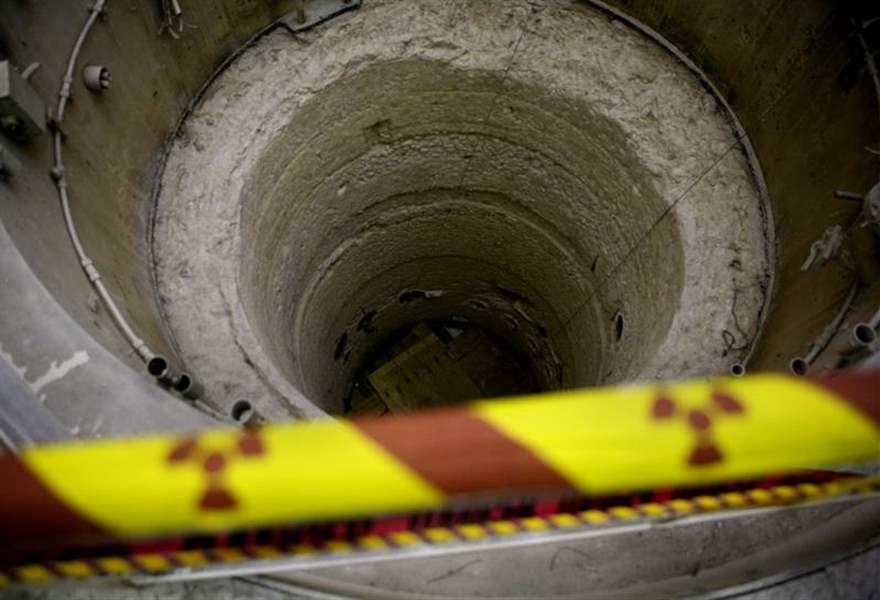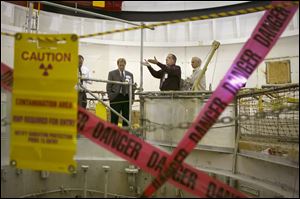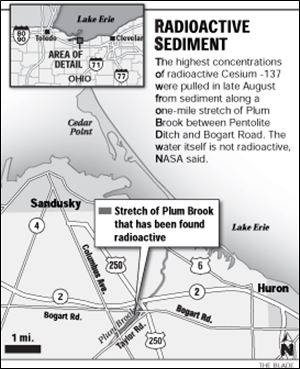
Radioactivity found in Lake Erie tributary
10/19/2005
The reactor vessel once was housed in this receptacle. The reactor was built in 1958 and operated until 1973.

NASA's Keith Peecook explains decommissioning operations for the station, where a nuclear reactor once was in use.
SANDUSKY - One of Lake Erie's smallest tributaries has been radioactive for at least 32 years.
NASA officials revealed yesterday that a one-mile stretch of Plum Brook, between Pentolite Ditch and Bogart Road, has soil with isotopes of radioactive Cesium 137 that are barely above natural background levels. To a much lesser extent, there also are microscopic traces of radioactive Cobalt 60.
They attributed the contamination to past activities at NASA's former Plum Brook nuclear test reactor, four miles south of Sandusky. It operated between 1961 and 1973.
Keith Peecook, a senior NASA engineer and acting project manager of the site's decommissioning effort, said there likely was a pinhole leak that was never detected. NASA stopped discharging waste into Pentolite Ditch once the reactor was shut down in 1973, he said.
The effect of the discovery was not immediately clear.

The reactor vessel once was housed in this receptacle. The reactor was built in 1958 and operated until 1973.
The Nuclear Regulatory Commission and the Ohio Department of Health both agreed with NASA that there does not appear to be an imminent public health threat. Neither was sure if a cleanup would be necessary until further testing is completed.
The state health department is not even sure if the contamination - which may not even have been caught without modern detection equipment - is significant enough for warning signs to be posted, Bret Atkins, an agency spokesman, said.
NASA has agreed to split new samples it takes with the state health department. Both will run separate tests and compare results, Mr. Atkins said.

NASA will, if necessary, spend the money it takes to clean up the creek. It will release its plan for the added sampling in about three weeks, Mr. Peecook said.
Results from preliminary tests were done at depths of up to 18 inches. NASA went outside its property after finding elevated levels of those radioactive materials near its gate at Pentolite Ditch, which flows into Plum Brook, he said.
Plum Brook flows into Lake Erie's Sandusky Bay. None of the water has radioactive material beyond permitted levels, though that doesn't mean the material is never stirred up. "Obviously, there has been some movement over the years," Jan Strasma, an NRC spokesman, said.
U.S. Rep. Marcy Kaptur (D., Toledo) yesterday said she is trying to get NASA Administrator Michael Griffin and NRC Chairman Nils Diaz to visit the region because it is "no stranger to safety and environmental concerns over nuclear issues."
"The recent meltdown threat at the Davis-Besse nuclear reactor was ranked as one of the most serious nuclear threats in U.S. history. News of radioactive contamination spreading off-site will be troubling to many, and it is paramount that we keep the public educated throughout this process," she said.
At 60 megawatts, NASA's Plum Brook reactor was a fraction of today's utility-scale reactors that generate electricity, which often are 900 to 1,000 megawatts. Yet during its heyday, the Plum Brook test reactor was one of America's 10 largest for nuclear research. It focused on nuclear-powered rocket propulsion.
The reactor, built for $15 million in 1958, sat in a mothballed state for years. NASA got the NRC's authorization to start dismantling it in March, 2002.
The dismantling effort originally was to be completed in 2007 at a cost of $160 million. It will take until at least 2010 and now could potentially cost "tens of millions" more, Mr. Peecook said as he discussed the anticipated budget shortfall while leading reporters on a tour.
He said NASA remains committed to restoring the site to "greenfield" status - that is, restoring it so it is clean enough for farming or residential use.
Mr. Peecook said NASA has spent all but $20 million so far. It has excavated more than 10 million pounds of contaminated soil from its 6,000-acre site and eight million pounds of low-level radioactive waste.
The spent reactor fuel, the only high-level radioactive waste, was sent for reprocessing at the U.S. Department of Energy's Savannah River complex in South Carolina in 1973. Much of the other metal-based material went to that state's Barnwell dump, one of the nation's few licensed to accept low-level waste.
Everything still on the site, including contaminated soil, can be sent to the Envirocare facility in Utah, Mr. Peecook said.
Contact Tom Henry at:
thenry@theblade.com
or 419-724-6079.